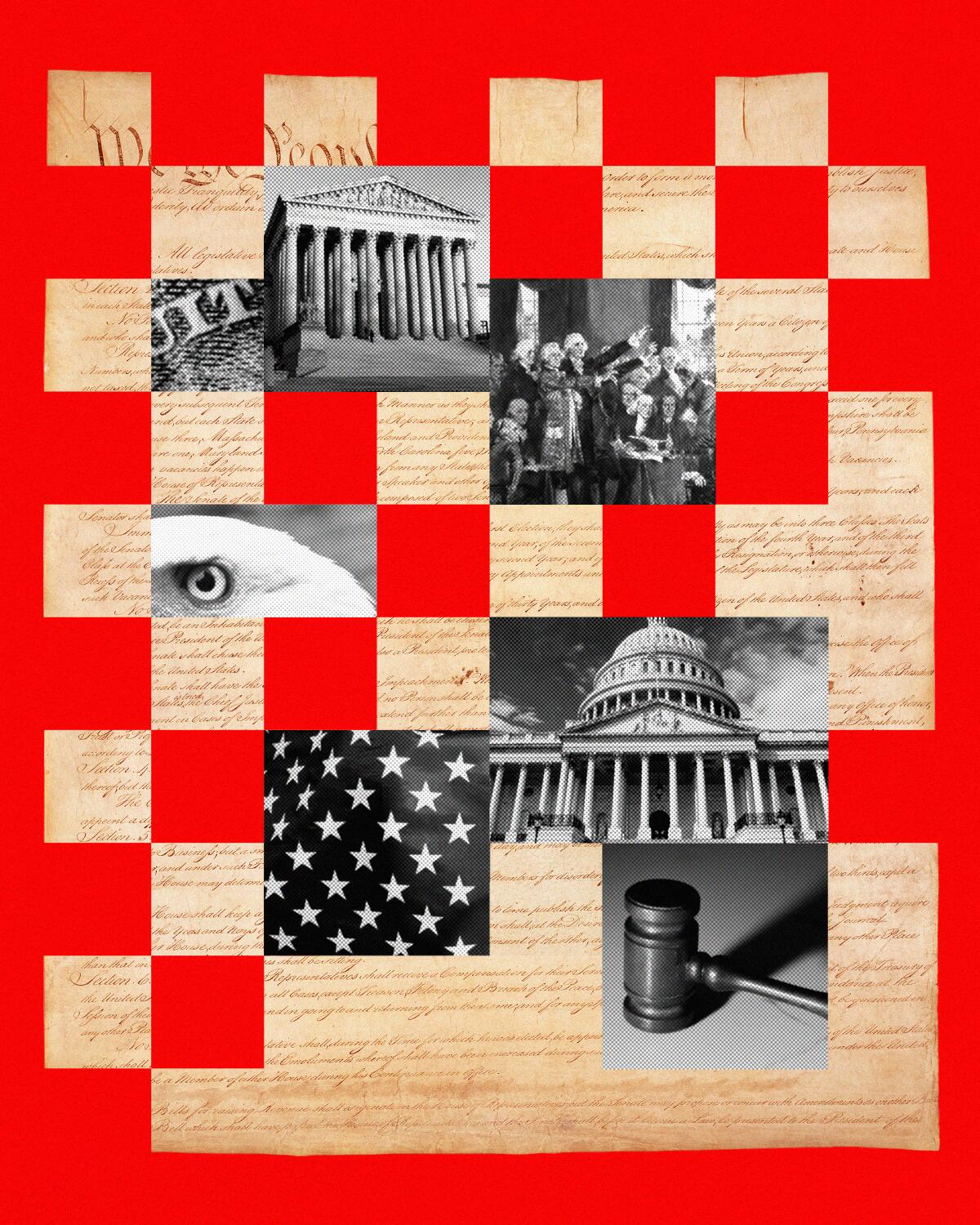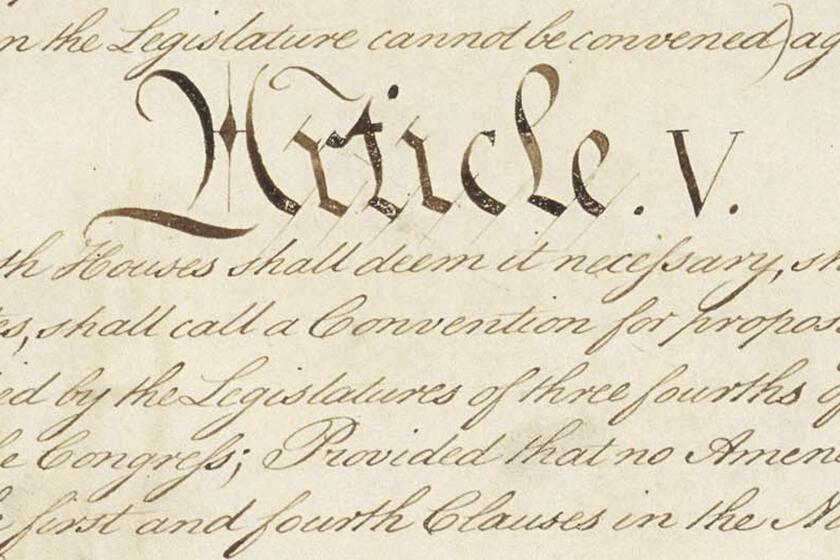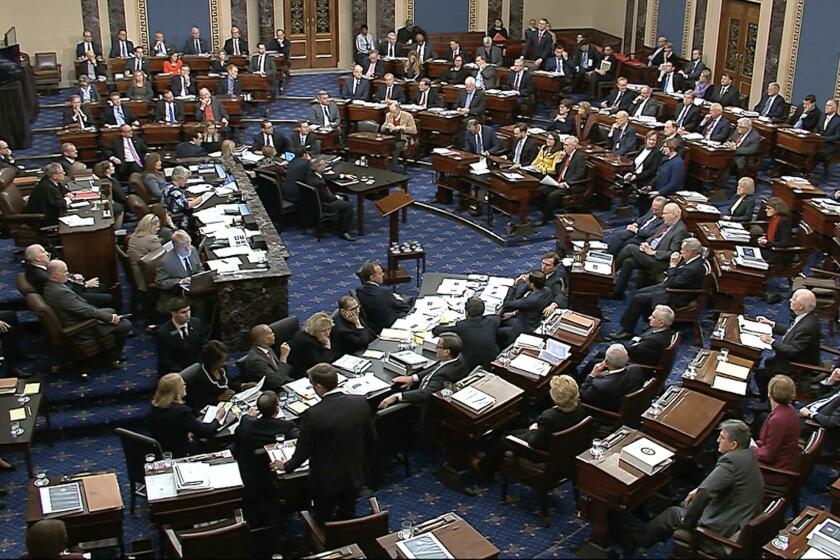Opinion: We’re living under a flawed Constitution. Let’s start fresh and rewrite it

- Share via
No matter the outcome of the November elections, it is urgent that there be a widespread recognition that American democracy is in danger and that reforms are essential. No form of government lasts forever, and it would be foolhardy to believe that the United States cannot fall prey to the forces that have ended democracies in many other countries.
Although the causes are complex, many of today’s problems can be traced back to choices made in drafting the Constitution, choices that are increasingly haunting us. After 200 years, it is time to begin thinking of drafting a new Constitution to create a more effective, more democratic government.
What does it mean for the U.S. president to ‘take Care that the Laws be faithfully executed,’ as the Constitution requires?
Signs abound that American democracy is in serious trouble. Confidence in the institutions of American government is at an all-time low. The Pew Research Center has been tracking public trust in government since 1958. It has gone from a high-water mark of 77% in 1964 to our contemporary 20%. A poll in September 2023 indicated that only 4% of U.S. adults said the American political system worked “extremely or very well.” A recent Gallup poll had only 16% of Americans expressing approval for how Congress is performing its job.
At the same time, the country is more deeply polarized than it has been since Reconstruction. There are many measures of this. Over the course of the Trump presidency, an average of 87% of Republicans approved of Trump’s handling of the job, compared with just 6% of Democrats. That, by far, is the largest gap in history. In August 2022, about 18 months into the Biden presidency, his approval rating among Democrats was 78% and among Republicans just 12%, a gap of 66%, which is less than during the Trump years, but still stunning, and reflects a deeply cleaved country.
At a moment of intense polarization, demagoguery and norm-breaking, the idea of throwing open the Constitution to broad revision is a frightening prospect.
Especially individuals in their 20s and 30s are losing faith in democracy. A Brookings Institution study found that 29% of “young Americans say that democracy is not always preferable to other political forms.”
The framers of the Constitution, out of distrust for democracy, created the Electoral College so that elites would choose the president. However, never in the 20th century did the loser of the popular vote become president because of the Electoral College. But population shifts and partisan realignment have made this a regular occurrence in this century. It happened in 2000 and 2016, and it almost happened in 2004 and 2020. In the last election, if just 42,921 votes had changed in Arizona, Georgia and Wisconsin, Donald Trump would have been reelected president despite losing the popular election by almost seven million votes.
This messy state of affairs began with a messy compromise. To secure approval and ratification of the Constitution, the framers agreed that each state would be represented in an upper chamber of Congress by two senators. When the Constitution was written, the most populous state (Virginia) had 12 times more people than the least populous state (Delaware). According to the 2020 census, the most populous state (California) has 68 times more people than the least populous state (Wyoming). This makes the Senate ever more egregiously undemocratic. In the last session of Congress, the 50 Democratic senators represented 42 million more people than the 50 Republican senators did.
With Washington unable to act because of partisanship and enmity, many Americans are hunting for solutions.
Changes in the rules of the Senate in the 1970s have made filibusters much easier and legislating much more difficult. Now it takes 60 votes to pass any bill other than the budget. The result is that a minority of senators representing a small fraction of the population can block any legislation.
The House of Representatives was intended to be the one body created by the Constitution that was representative of the people. But partisan gerrymandering — where the political party that controls each state’s legislature draws election districts — has become vastly more effective because of sophisticated computer programs and voter data. For example, in Pennsylvania, over several elections, the congressional elections in districts drawn by the Republican legislature resulted in Democrats’ receiving between 45% and 51% of the statewide vote, yet winning only 5 of 18 House seats.
Unfortunately, the Supreme Court in 2019 held that federal courts cannot hear constitutional challenges to partisan gerrymandering. The justices have also undermined democracy by gutting key provisions of the Voting Rights Act and thwarting campaign finance reform.
But although the problems are grave, I believe that the situation is not hopeless. It is both possible and essential to cure the defects and save American democracy. There are many meaningful changes that can be made without constitutional amendment. The Senate can change its rules to eliminate the filibuster. Congress, by legislation, can end partisan gerrymandering for seats in the House of Representatives. The Supreme Court can end partisan gerrymandering altogether. The size of the House of Representatives can be increased to make it more democratic. New legislation can be passed to protect voting rights.
As for the flaws in the Constitution, virtually every one can be fixed by amendment if there is the will to do so. Amending the Constitution is enormously difficult, but not impossible. Although amendments have been rare in recent decades, there have been times in American history when they have been more common. From 1913 to 1920, there were four amendments, which included authorizing an income tax, creating popular election of senators and providing women the right to vote.
And there is an alternative to a spate of separate amendments: starting fresh by passing a new Constitution. It does not take much reflection to see the absurdity of using a document written for a small, poor and relatively inconsequential nation in the late 18th century to govern a large country of immense wealth in the technological world of the 21st century.
It may seem strange and frightening to suggest thinking of a new Constitution at a time of great partisan division. But that existed in 1787; in many of the states, the Constitution was just barely ratified.
I do not minimize the difficulty of significant change in any of these ways. But we must face the frightening reality of the country’s future if there are not major reforms. My hope is that looking at that abyss will be the impetus for beginning to realize the need for action and starting the long-term process of making it happen.
Erwin Chemerinsky, a contributing writer to Opinion and dean of the UC Berkeley School of Law, is the author of “No Democracy Lasts Forever: How the Constitution Threatens the United States.”
More to Read
A cure for the common opinion
Get thought-provoking perspectives with our weekly newsletter.
You may occasionally receive promotional content from the Los Angeles Times.













